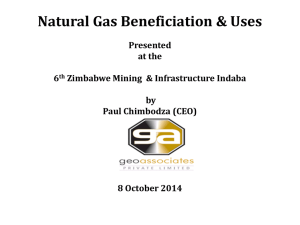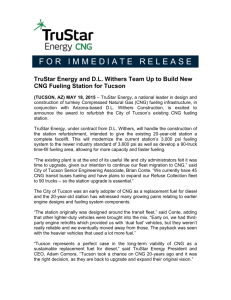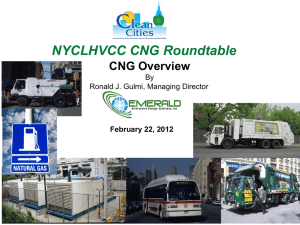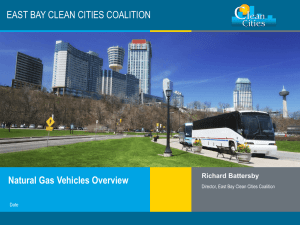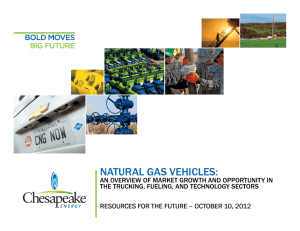Natural Gas Fleets
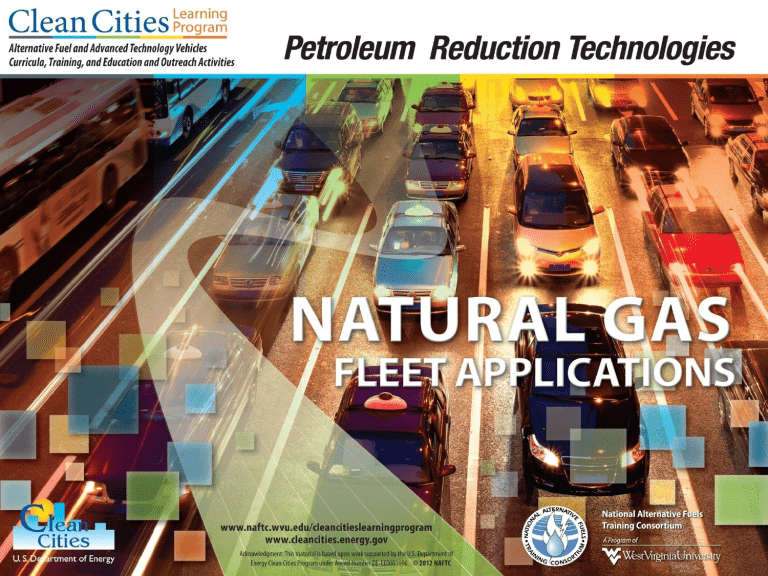
Objectives
Explain how to implement green fleets
Learn about incentives for converting to natural gas fleets
Learn about the availability and cost of natural gas
Identify the advantages of using natural gas
Understand how to safely handle natural gas
2
Greening of Fleets
Why use green fleets?
Reduce operating costs
Reduce greenhouse gas emissions
Improve corporate image
3
How to Implement Natural Gas
Get buy-in
Create long-term objectives
Avoid setting reduction goals in absolute numbers
Anticipate obstacles
Move slowly
Improve vehicle use
Track and report progress
4
Natural Gas Fleets
Natural gas = hydrocarbon fuel; mostly methane
Natural gas is a fossil fuel
Natural gas has a higher flammability than conventional gasoline
Natural gas has a lower volumetric energy density compared to liquid fuels
5
How is Natural Gas Formed?
Fossil fuel – nonrenewable
Decay of organic matter over time
Coal, oil, stand-alone wells
Biogas – renewable
Landfills
Agriculture
Stored as CNG or LNG
6
CNG
Natural gas is compressed and stored as a gas
Stable method of containment
3000-3600 psi
Figure 1 (left): Factory available Honda Civic CNG passenger car. Source: NAFTC.
Figure 2 (right): Corresponding CNG trunk-mounted tank. Source: NAFTC.
7
LNG
Natural gas is cooled below
-260 ° F
Stored at lower pressures
If released, LNG will quickly evaporate
Considered a cryogenic liquid
Storage tanks are called dewars
Figure 3: Cutaway of LNG tank showing dual walls and insulation. Source: NAFTC.
8
Incentives for Using Natural Gas in
Fleets
Incentives
Partnership initiatives and pooled resources
Financial subsidiaries
Informational tools
Initial cost vs. federal and state incentives
American Recovery and Reinvestment Act
(ARRA)
Clean Cities Program
9
Tax Incentives
Tax incentives for natural gas fuel, vehicles, and infrastructure have been provided through federal law
In addition to federal incentives, 25 states currently offer to help in the development of the market
10
Federal Grant Funding
Federal government = largest grant provider
U.S. Department of Energy (DOE)
U.S. Department of Transportation (DOT)
Environmental Protection Agency (EPA)
U.S. Department of Agriculture (USDA)
11
State Grant Funding
State Energy Office (SEO)
National Association of State Energy Officials directory
Alternative Fuels Data Center map
To find state-specific information, visit www.afdc.energy.gov/afdc/laws/state
12
Incentives for Natural Gas Production
Recently doubled estimates of U.S. natural gas reserves
Expanded drilling options available
Cleaner burning domestically produced gas
State incentives for increased production
Local biomass projects
Use of renewable biogas over natural gas
13
Natural Gas Availability and Cost
Currently, there are 300,000 miles of natural gas pipelines in U.S.
Most public fueling stations are CNG because fleets using LNG have dedicated infrastructure
Consumption has increased 145% nationwide since 2005
14
Figure 4: Natural Gas fueling stations by state. AFDC.
15
Research shows the cost of diesel fuel is projected to increase at a linear rate of 5.6% per year
Increase in natural gas = 1.6% per year
Figure 5: EIA Fuel Price Projections. Source: EIA.
16
Figure 6: Cost comparison - diesel, gasoline, & compressed natural gas. Source: AFDC.
17
Natural gas price depends upon:
Cost of production
Demand for natural gas
87% domestically produced
18
Natural Gas Advantages
Reduced greenhouse gas and particulate matter emissions
Reduced long term operating costs
Domestically produced
Higher compression ratios
19
Things to Consider
Limited vehicle availability and initial cost
Shorter driving range
Limited public fueling stations
20
Natural Gas Performance and Safety
Performance
Conversions have similar performance
May sacrifice some power
Dedicated and purposed built may have better performance
Can utilize higher compression ratio for increased engine efficiency
21
Natural Gas Performance Summary
• Similar vehicle performance
• High octane rating
• Cleaner exhaust emissions
• Fuel tank size can be large
• Limited vehicle fueling stations
22
Safety
NGVs have excellent safety record:
Integrity of the NGV’s fuel storage and delivery system
Properties of the fuel itself
Natural gas is highly flammable
Excellent for combustion
Should be handled with same care given to other combustible fuels
23
Safety
Natural gas cylinders are much thicker and stronger than gasoline or diesel tanks
The National Fire Protection Agency
(NFPA) and U.S. DOT identify hazards with diamond placards
24
Tanks
CNG
Produced to meet reliability and performance standards
3 year or 36,000 mile tank inspections
LNG
Visual inspection for corrosion
Label
Figure 7: Example of LNG tank label. Source:
NAFTC.
25
NFPA Placards and Specifications
Four colored diamonds within outer diamond
Inner diamonds dictate health, fire, reactivity, and other hazard information
Different diamonds for different substances
Figure 8 (left): NFPA hazard placard for CNG. Source: NFPA.
Figure 9 (right): NFPA 704 hazard placard for LNG. Source: NFPA.
26
U.S. DOT Placards and Specifications
Help identify what fuel is being transported
Different placards for different forms of fuel
Proper officials should be contacted to ensure correct placards are displayed
Figure 10 (left): CNG transport placard for UN 1971. Source: U.S. DOT.
Figure 11: LNG transport placard UN 1972. Source: U.S. DOT.
27
Natural Gas Safety Summary
• NGVs must meet stringent safety codes
• Safe and durable storage tanks
• Tank inspections
• Exposure causes minimal injury
28
Test Your Knowledge
True or False: The price of natural gas based on a gasoline gallon equivalent is typically lower than gasoline.
What are the two forms of natural gas storage?
True or False: Fueling stations for natural gas are located in nearly all locations of conventional fuel stations.
Natural gas engines can utilize higher __________ due to its higher ___________ rating.
True or False: Natural gas vehicles require periodic fuel tank inspections.
29

